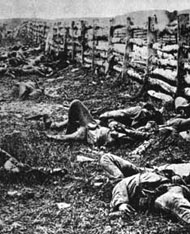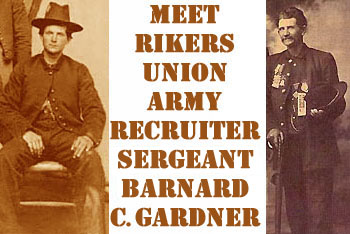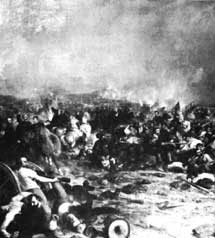
 NPS Antietam web image. |
 |
 NPS Gettysburg web image. |
Born in Lenox, Madison County, NY, Gardner and his family had moved to Hampton area of Long Island by 1860. He was in the construction business with his father. Barnard, whose specialty was building staircases, from the strictly
serviceable to the gracefully elegant, worked on many of the large Victorian
homes on Long Island. Records indicate the Gardners purchased their building materials from a Dix Hills lumber company.
Barnard enlisted with friends in Company H, 1st Regiment U.S. Sharp Shooters at Babylon in western Suffolk County's South Shore August 24, 1861. But joining USSS involved more than simply stepping forward and signing up.
Applicants were given a shooting test at a
'target ground' that was located in Brooklyn near what is today Greenwood
Cemetery: to fire in rapid succession 10 shots hitting a 10" circle on white paper from 200 yards while at a rest and from 100 yards while standing. Those who hit the mark were sworn into what became their era's elite Special Forces, wearing distinctive green uniforms so they might be better camouflaged to carry out their Special Ops missions near or behind enemy lines.
At 19, Barnard was not physically overwhelming. He stood just about 5 foot 7 and was no heavy weight. But on that Long Island firing range his gray eyes zoomed in on the distant paper target as easily as they often had zoomed in on the tiny head of nail to be hammered into a wooden beam. There is reason to believe his shooting skills had been honed hunting water game (ducks and geese) for the family dinner table and the local meat markets.
The following month (September), he and his fellow sharpshooters of Company H -- all New Yorkers, as were members of Companies A, B and D -- arrived in Washington for additional training at a "Camp of Instruction" north of the city. They also became part of the capital's defense, officially "unattached" to the Army of the Potomac under Brig. Gen. Fitz John Porter. After a few weeks there, Private Gardner was promoted to Corporal.
The new corporal and his comrades-in-arms experienced plenty of action in succeeding months: "Big Bethel" reconnaissance, the Howard's Bridge skirmish, the Siege of Yorktown, the Battles of Williamsburg, Hanover Court House, the "Seven Days Before Richmond," Mechanicsville, and Gaines' Mill.
After the latter, they were posted to defend Chickahominy River roads and bridges. Barnard's company had picket duty in the vicinity of Seven Pines, the Union post closest to Richmond. There they remained until 3 AM Sunday, June 29, 1862, before being ordered to fall back after virtually all other Union forces had already been pulled back, leaving the marksmen the last to leave and at risk of being overtaken by rebel troops. Barnard was captured that night and held for six hours before he made his escape on foot.
Not long afterwards, Barnard began duty with the Company H's Commissary. A military commissary's mission is to help an army that proverbially moves on its stomach to keep moving. Thus a company commissary unit must get the food and get it to the men. Some of those food supplies may be available from temporary depots set up to serve entire regiments or divisions.
A company commissary wagon would go to the depot to pick up and bring back supplies. In situations where such depot pickups were not practical or possible, other methods might have to be employed, such as acquiring food from locals through purchase and/or confiscation. At other times, the sharpshooting skills of an experienced game hunter like Gardner would be pressed into service.
During the year or so that the corporal's company was associated with the general's command in many military movements and engagements, did Porter and Gardner ever encounter each other personally? Even if they did, no way would they have foreseen that Rikers awaited them both in their separate futures -- Gardner in 1863/4 as a Union Army recruiter based on the island; Porter as NYC Mayor Franklin Edson's Police Commissioner in 1884, the year the city purchased the island and turned it into a prison farm colony.
Input from the West Point-trained former field general become police commissioner would surely have been solicited regarding the best deployment of the correctional force and its prisoners on the newly-acquired island. Particularly so since Porter had served a decade earlier as Public Works Commissioner in the administration of anti-Tweed reform-minded Mayor William H. Wickham.
The forays by Cpl. Gardner and his fellow sharpshooters probing the countryside to detect the whereabouts and strength of Confederate forces contributed updated intelligence that helped Gen. Porter make the fateful (and ultimately vindicated) decision not to implement Gen. John Pope's order to attack Confederate General Stonewall Jackson's forces during Second Bull Run, Manassas II, August 28-30, 1862.
The sharpshooters' reports were a factor considered significant in Porter not following that attack order. They informed him of something Pope did not know and could not have known when issuing the battle directive. Porter learned a massive force under rebel General James Longstreet had arrived in such overwhelming numbers that attacking them then would have meant hopeless and purposeless slaughter likely crippling the Union cause in that theatre of operations.
Dawkin's Branch, about two miles northwest of Manassas, is where Porter received the all-important intelligence reports on General Longstreet's troops and where Porter received the attack-Jackson order from Pope unaware of the Longstreet army arrival. Dawkin's Branch also is where Gardner was captured Aug. 29th while positioned far-forward gathering fresh information for the enemy troop movement reports to Porter. Although held through the night, the corporal was able to escape on foot the next day to rejoin his company and participate in the major struggles at Groveton (2nd Manassas). Pope blamed Porter for the defeat. Porter was later court-martialed and found guilty. He would spend much of the next quarter century in eventually successful efforts to clear his name, reverse the conviction and gain military reinstatement, at least for the record.
Complicating that process were political overtones and undertows. Porter had been a close friend -- during and after their military service -- of Gen. George McClellan, Lincoln's Democratic opponent in the 1864 Presidential election. Thus, Democrats tended to be more sympathetic, responsive and even supportive of Porter's appeal; Republicans, more reluctant, resistant and even antagonistic.
While McClellan remained in overall charge of the Union Army, he was able to shield Porter. Consequently, for some weeks after Bull Run II the latter continued in command of troops -- including 1st Regiment U.S. Sharp Shooters -- during a series of engagements near and at Antietam in September 1862.
At Antietam, the 1st Regiment Sharpshooters initially were held in reserve near McClellan's headquarters. On Sept. 19th, Confederate forces moving westward out of Sharpsburg crossed the Potomac River at Blackford's Ford. The 1st USSS riflemen were ordered by Gen. Porter to cross the river and drive the enemy from the bluff, which they did. The sharpshooters waded through the waist-deep water under heavy fire, one of them being killed and several wounded (including Barnard who was hit in the left arm). About a week-and a-half later, Cpl. Gardner was promoted to sergeant.
The Battle of Antietam, perhaps the bloodiest of the conflict, is regarded as the turning point of the war. Union's repulsing of Lee's forces there is credited with (1) removing any serious chance of foreign recognition of the Confederacy or intervention on its behalf and (2) providing Abraham Lincoln the opening he wanted, and used five days later, to announce the Emancipation Proclamation identifying the cause of American Union with that of human liberty. |
home page |
USCTs |
Civil War letters | Civil War prisons |
terrorists in NYC |
|
| ||||